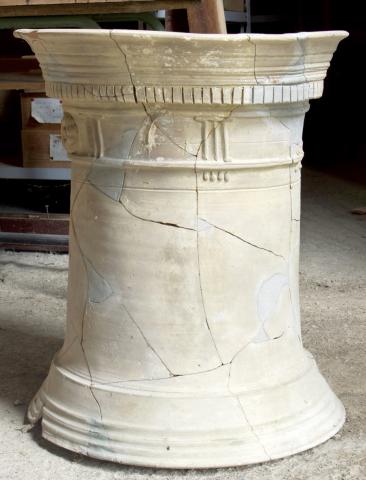Hidden Treasure
A Bryn Mawr archaeologist sets out to unravel the mystery of the terracotta altars of Morgantina.
By 212 B.C.E., the prosperous Greek city of Syracuse on the east coast of Sicily had already withstood a three-year siege by the Roman army. The city was starving, however, and calls for a peaceful surrender grew louder.
Instead, the standoff ended on more violent terms. A local captain agreed to open the city gates for the Romans in exchange for his own survival after the war. The Romans plundered Syracuse and killed many of its citizens, including the mathematician Archimedes. But a few might have escaped and fled inland.
This is one possible explanation for how a group of 14 silver objects, including a miniature altar, made their way to the remote town of Morgantina in central Sicily, where they were concealed beneath the beaten-earth surface of a home far from the city center. Whoever buried these objects never returned for them, as Morgantina, too, was sacked by the Romans the following year. The silver treasure remained hidden for over 2,000 years before it was looted in the 20th century.
The little silver altar from this hoard—the only known example of its kind—stands less than five inches tall but resembles a monumental Greek temple. Its cylindrical body is crowned by a frieze of triglyphs, metopes, and dentil moldings, while bucrania (decorative ox skulls) and garlands adorn the surface below, symbols appropriate for a Greek sacrifice.
The altar is unique, but hundreds of similar clay altars have been found at sites around Sicily. I first encountered them as an undergraduate on my first excavation in Italy when I visited the Paolo Orsi Archaeological Museum in Syracuse, not far from where the Romans first breached the city walls. This was before I came to Bryn Mawr for graduate school in archaeology, before I even knew that I would pursue my interest in the classical world. But even then I was struck by their peculiar form and miniature architectural designs.
How could these diminutive objects function as altars? Were they used for animal sacrifices, or perhaps smaller gifts of vegetables or incense? And which gods received these offerings? Were they kept privately by individuals, shared by families in the household, or maintained by priests in a sanctuary? Did the Romans continue to use them in the Greek cities they captured? Are they even really altars?
Such questions guide my dissertation research on the terracotta altars of Morgantina. The altars, most of which survive only as fragments, contain some answers. But the key to understanding their role in Greek and Roman religious rituals might lie in the notebooks, drawings, and photographs that document their discovery. From archival records kept in the Sicilian town of Aidone, I learned that these altars were not confined to houses and sanctuaries but were widely distributed in shops, in administrative buildings in the agora, and in a bath complex on the outskirts of town. Excavation notebooks, some over 70 years old, record that some were found in household courtyards while others were clustered around larger stone altars in sanctuaries. These objects might have been more versatile than typically assumed, used in households for small sacrifices and libations but also as dedications in sanctuaries in commemoration of, or even as a substitute, for real animal sacrifice.
On Site
Thanks to Bryn Mawr’s Bryne Rubel Travel Fellowship, Andrew Tharler, M.A. ’13, went to the source to study altars at different sites and museums in Sicily and to broaden his understanding of the significance of these enigmatic artifacts to the ancient cultures that used them.
Published on: 03/16/2018

